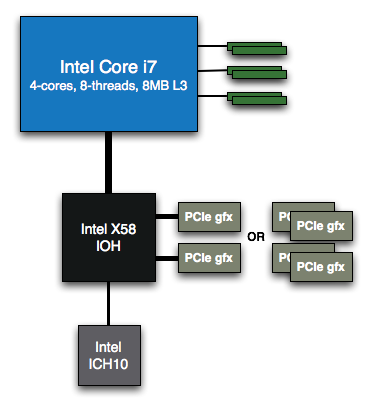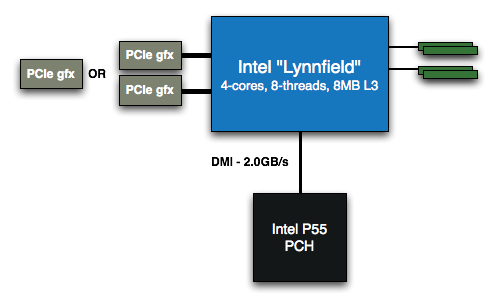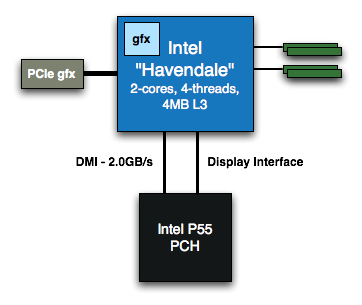Nehalem Part 3: The Cache Debate, LGA-1156 and the 32nm Future
by Anand Lal Shimpi on November 19, 2008 8:00 PM EST- Posted in
- CPUs
Mainstream Nehalem: On-chip GPU and On-chip PCIe
Let’s take a look at the Core i7, the first Nehalem incarnation:

Three DDR3 memory channels, a QPI link to the X58 chipset and support for multiple GPUs off of the X58 IOH. The Core i7, as you know by now, plugs into Intel’s new LGA-1366 socket. But in the second half of next year, there will be a new socket for mainstream users: LGA-1156.
Meet Lynnfield, it’s also a 4-core/8-thread design with an 8MB L3 cache, just like the Core i7, but it plugs into LGA-1156. Instead of 3-DDR3 channels it’s got two and instead of QPI it’s got Intel’s DMI connecting it to the chipset. It’s a lower bandwidth interconnect but Lynnfield doesn’t need a ton of bandwidth between it and the chipset, the reason being its secret weapon: Lynnfield has an on-package PCIe controller.

There are 16 PCIe lanes on Lynnfield (presumably PCIe 2.0) and they can be used as two x8s or a single x16, so you’ll get 2-way SLI/CrossFire support assuming all licensing silliness is worked out. The close proximity of the PCIe controller to the CPU could mean some very interesting things for latency, if well designed Lynnfield could have the lowest latency CPU-GPU connection we’ve seen on a desktop PC. Whether or not that’ll actually mean anything for real world performance remains to be seen, I’d guess not but it’s neat to talk about nonetheless.
Next up we’ve got Havendale, this is a 2-core/4-thread part with a 4MB L3 (still 2MB of L3 per core, just like Lynnfield and the Core i7). The “pinout” (if we can still call it that on these pinless CPUs) is the same as Lynnfield, so we’ve got a two channel DDR3 memory controller and DMI to the chipset.

Havendale’s secret sauce is that it’s got an on-package GPU, I’d expect it to be a bigger, better, faster variant of G45 (hopefully a lot better/faster) built on a 45nm process. This should beat AMD to the punch with the first single-chip CPU/GPU for mainstream desktops/notebooks, as AMD delayed its first APUs until 2011. Alongside the on-package GPU we've also got the same PCIe controller from Lynnfield.
The actual display output on Havendale will be through the chipset itself but the GPU and PCIe interface are on the CPU’s package. Harvendale only offers a single x16 PCIe slot, you can’t run it in 2 x8 mode.
At the right clock speeds, Havendale should be perfect for notebooks and desktops as well. These days two-cores with Hyper Threading would be the perfect mixture of cores/performance for the majority of consumers. As I noted in part 2 of our Nehalem coverage, give me Nehalem’s power efficiency in a notebook and I’ll be beyond happy.
The hiccup however is that we won’t see Havendale until Q1 2010. It’ll start production in Q4’09 but systems won’t ship until the beginning of the next year. This does leave a hole in Intel’s Nehalem roadmap as there won’t be any Intel integrated graphics chipsets between now and Q1 2010, which should give NVIDIA ample opportunity to sell chipsets into the mainstream Nehalem market.










33 Comments
View All Comments
blyndy - Thursday, November 20, 2008 - link
Yeah I think that Intel has failed to be consistant between Penryn/Nehalem, or at least bit off more than it could chew...I mean, tick-tock is fine and all, but Penryn has really held up as an ideal architecture, as something to grow off, not as something that should be immediately succeeded by 'the biggest architectural redesigns since the Pentium 1'. After all Core/2 IS the fruit of the P3/Pentium M. Nehalem on the other hand smells unpleasantly P4-like, due in large part to hyperthreading.
HT's something that you either see as 'reduces single thread performance, consumes transistors adds arch bloat and adds heat' or as 'OMG MOAR CPUs IN TASK MANAGERZOMG!!!'. And it's funny because at the end of the day it still runs into the same question as the core-count issue --'are these additional execution units adequately utilisable by a DIVERSE set of applications (i.e. NOT JUST vid encode...)?'. Because we know threading is HARD.
OK I'll come clean-I just what to know when are they going to dust off the wolfdale masks and shrink 'em onto 32nm? :D
esgreat - Thursday, November 20, 2008 - link
Well tell me where does the mainstream user want for in performance other THAN video encoding and image processing?Games? Games have shown to be much more limited to GPU side. Most CPU enhancements can't really make huge impacts on games nowadays. This is unless they try to utilize more cores, which is what they have done: provide the hardware so that software could use it. The software is fast right now because things like SSE were introduced years ago (although they weren't beneficial then).
As for video encoding, cutting down encoding time from 30 minutes to 10 minutes IS A BIG DEAL. And this is one application where many users (non gamers) would really use.
Enabling of multicore now means fantastic applications in the future.
cocoviper - Thursday, November 20, 2008 - link
Pretty good read.I'm hoping we can get some more detailed info about Intel's 32nm process in the next couple months- especially what they're planning to do with Atom and 32nm.
CEO Ballmer - Wednesday, November 19, 2008 - link
AMD is still in the game?I had written them off!
http://fakesteveballmer.blogspot.com">http://fakesteveballmer.blogspot.com
Derbalized - Thursday, November 20, 2008 - link
AMD is still in the game.AMD is designing Intels next chip.
Probaly with an integrated memory controller also.
Derbalized - Thursday, November 20, 2008 - link
I probaly should have spelled probably right. LOLpiesquared - Wednesday, November 19, 2008 - link
Nope, don't give a shit. But do want to know what keeps happening to all these AMD and ATI reviews you keep promising over and over.chizow - Thursday, November 20, 2008 - link
LOL. There was a brilliant post on DT that basically claims AMD has now shifted their focus to producing Roadmaps. A bit harsh, but honestly pretty accurate.Wait til AMD actually releases a new product before getting all emo about a lack of AMD reviews.
whatthehey - Thursday, November 20, 2008 - link
You want an AMD review? Here's one for you: AMD's current products suck for the vast majority of users. The only place they're worthwhile is in the 8S server space; otherwise, they cost too much and deliver too little. Their dual-core parts were awesome when all they had to do was beat Pentium D, but Intel has progressed substantially since then and all AMD has got is a bloated, buggy, slow POS known as Phenom. At least the name is right: it's a phenomenal failure.Or maybe you mean the various ATI reviews posted during the past couple months?
http://www.anandtech.com/video/showdoc.aspx?i=3441">http://www.anandtech.com/video/showdoc.aspx?i=3441
http://www.anandtech.com/video/showdoc.aspx?i=3437">http://www.anandtech.com/video/showdoc.aspx?i=3437
http://www.anandtech.com/video/showdoc.aspx?i=3420">http://www.anandtech.com/video/showdoc.aspx?i=3420
http://www.anandtech.com/video/showdoc.aspx?i=3415">http://www.anandtech.com/video/showdoc.aspx?i=3415
http://www.anandtech.com/video/showdoc.aspx?i=3405">http://www.anandtech.com/video/showdoc.aspx?i=3405
Oh, but that's not good enough for the AMD fanboyz! Everyone needs to baby AMD and talk about how awesome they are, when AMD is busily circling the drain and getting ready to spin off their fabrication to a separate company. ATI is doing pretty well, and AMD made some good hardware in the past; unfortunately, it doesn't look like they were able to continue to compete.
And honestly, it's no big surprise. Even Intel is having a tough time competing with their own products. Nehalem is a nice design, but as I've told others we are at the point where 95% of people don't need anything more than a three year old Athlon 64 X2. Quad-core only matters to a small number of desktop users at best, and here Intel and AMD are both looking to hex-core and octal-core in the not too distant future. That's great if you do video work or 3D rendering, but pretty much useless for everyone else.
I lust after the new Nehalem upgrades as much as the next guy, but invariably I come back to the realization that my pathetic Q6600 @ 3.00GHz (yes, I backed off from 3.6GHz when I realized that the extra voltage and stress on the system wasn't actually improving performance in any of the applications I use on a regular basis) was more than fast enough for any current program. About the only thing I need right now is an upgrade in the video card department, and I don't need Nehalem for that!
Griswold - Thursday, November 20, 2008 - link
After reading"AMD's current products suck for the *vast majority* of users"
I knew that your entire posting would have less substance than a steaming pile of cow dung. Why is it that the most clueless people always type up the biggest shitstorm of incoherent garbage..?